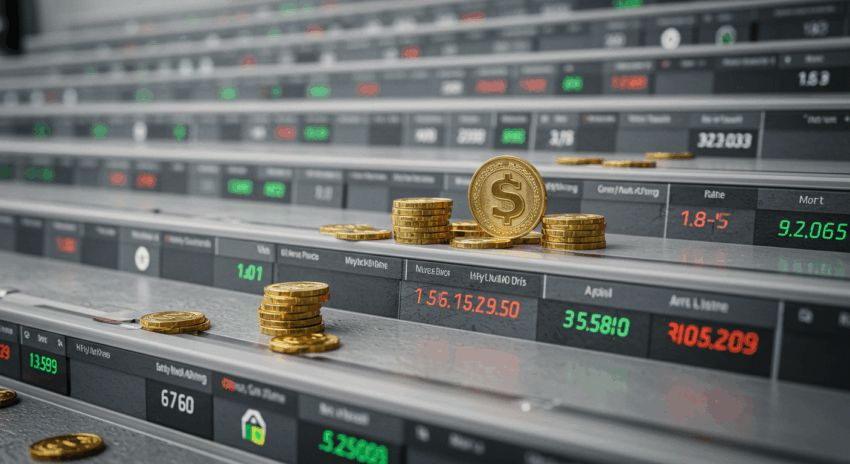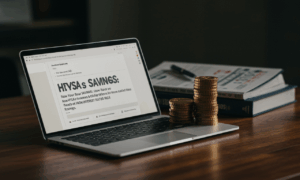High-yield Certificate of Deposit (CD) rates are currently one of the most talked-about topics in personal finance, offering savers a compelling opportunity to grow their money with minimal risk. In a notable recent development, several financial institutions have pushed their Annual Percentage Yields (APYs) to levels not seen in over a decade, with some offers now topping an impressive 5.50%. If you’ve been looking for a safe and effective way to make your savings work harder, this news is highly relevant to your financial goals. This article will deconstruct what’s happening with these exceptional rates, explain the mechanics behind this powerful savings product, and help you understand how it compares to other options in your financial toolkit.
We will delve into the data, explain the underlying economic forces driving this trend, and provide the insights you need to determine if a high-yield CD fits into your personal financial strategy. Let’s explore this significant shift in the landscape of savings products.
The News Unpacked: What’s Happening with CD Rates?
In the past few days, the financial world has seen a continued surge in the rates offered on Certificates of Deposit. While high-yield savings accounts have been getting a lot of attention, CDs are now stepping into the spotlight. A number of banks, particularly online-only institutions and credit unions, have increased their APYs on short- to medium-term CDs (typically those with terms of 6 to 18 months) to 5.50% or even slightly higher.
To put this in perspective, these are some of the most attractive, risk-free returns available to consumers in more than 15 years. This isn’t just a minor adjustment; it represents a peak in a trend that has been building over the last two years. For savers who have grown accustomed to earning next to nothing on their cash reserves, this development is a game-changer. It provides a powerful tool to combat inflation and achieve short-term savings goals, such as saving for a down payment on a house, a new car, or a significant family vacation, with a guaranteed outcome.
A Refresher: What Exactly is a Certificate of Deposit?
Before we go further, it’s essential to understand the fundamentals of a Certificate of Deposit. Even if you’ve heard the term, the details are what make it a unique and valuable tool. A CD is a special type of savings account that holds a fixed amount of money for a fixed period of time. In exchange for your commitment to not touch the money for that period, the bank pays you a fixed interest rate, which is typically higher than what you would get from a standard savings or checking account.
Here are the core concepts you need to know:
- Term Length: This is the duration you agree to leave your money in the CD. Terms can range from as short as one month to as long as ten years. The most competitive rates recently are being seen in the 6-month to 2-year range.
- APY (Annual Percentage Yield): This is the most crucial number to look at. APY represents your total return over a year, factoring in the effect of compound interest. A higher APY means more money in your pocket.
- Fixed Rate: Unlike a regular savings account where the interest rate can change at any time, a CD’s rate is locked in for the entire term. This provides certainty and predictability, which is a major advantage for financial planning.
- Early Withdrawal Penalty: This is the main trade-off. If you need to access your funds before the CD’s term is up (it “matures”), you will have to pay a penalty, which is usually a portion of the interest you’ve earned. This is why you should only deposit money into a CD that you are certain you won’t need for the duration of the term.
- FDIC or NCUA Insurance: Just like traditional savings accounts, CDs from banks are insured by the FDIC (Federal Deposit Insurance Corporation), and those from credit unions are insured by the NCUA (National Credit Union Administration), typically up to $250,000 per depositor, per institution. This makes them one of the safest places to keep your money.

Why Are CD Rates So High Right Now? The Bigger Picture
The attractive CD rates we’re seeing aren’t appearing in a vacuum. They are a direct result of the broader economic policies being implemented by the U.S. Federal Reserve (the Fed). For the past couple of years, the Fed has been on a mission to control high inflation. Its primary tool for doing this is raising the federal funds rate, which is the interest rate at which banks lend to each other overnight.
When the Fed raises this key rate, it creates a ripple effect across the entire financial system. Borrowing becomes more expensive for everyone, from large corporations to individuals seeking a mortgage. For banks, this means they must also compete more aggressively for deposits from customers. To attract your money, they increase the yields they offer on their savings products, including high-yield savings accounts and, most notably for this discussion, Certificates of Deposit. The current high-rate environment is a direct consequence of this monetary tightening cycle. For anyone following trends in the wider economy, this connection between central bank policy and consumer savings rates is a crucial one to understand.
Comparing High-Yield CDs to Other Financial Options
With rates this high, how does a CD stack up against other places you could put your money? It all comes down to your goals, timeline, and risk tolerance.
- vs. Traditional Savings Accounts: The difference is stark. A traditional savings account at a large brick-and-mortar bank might offer an APY of 0.10% or less. A high-yield CD at over 5.50% will earn over 50 times more interest on the same amount of money. The trade-off is liquidity; you can pull money from a savings account anytime, but a CD requires you to lock it up.
- vs. High-Yield Savings Accounts (HYSAs): This is a closer comparison, as HYSAs also offer excellent rates right now. The key difference is that HYSA rates are variable. They can go up or down at any time based on the bank’s decisions and the Fed’s actions. A CD’s rate is fixed. If you believe interest rates might start to fall in the near future, locking in a high CD rate today guarantees you that return for the entire term.
- vs. The Stock Market: Investing in the stock market offers the potential for much higher long-term returns, but it comes with significant risk. You could lose a portion or all of your principal. A CD, on the other hand, offers a guaranteed return with virtually no risk to your principal (up to the insurance limit). Therefore, CDs are ideal for short-term goals or for the portion of your portfolio that you want to keep completely safe. For more on balancing risk and reward, you might explore different investment strategies.
Is a High-Yield CD the Right Move for You?
Deciding whether to open a CD involves evaluating your personal financial situation. While we cannot offer direct advice, here are some questions to ask yourself:
- What is the purpose of this money? If you’re saving for a specific goal with a clear timeline (e.g., a wedding in 18 months), a CD can be a perfect fit. If it’s your emergency fund, you’ll need the liquidity of a high-yield savings account instead.
- Can I commit to the full term? Be realistic about whether you can afford to lock away the funds without touching them. The early withdrawal penalties can negate the benefits of the high rate.
- How does this fit into my broader financial plan? CDs can be a fantastic component of a diversified financial strategy, serving as the low-risk, stable portion of your holdings. Some savers use a technique called a “CD ladder,” where they open multiple CDs with staggered maturity dates to balance access to funds with high returns.
Disclaimer: The information provided in this article is for educational and informational purposes only and does not constitute financial or investment advice. You should consult with a qualified financial professional before making any investment decisions.
Frequently Asked Questions (FAQ)
What happens if I open a 1-year CD at 5.50% APY and overall interest rates go up to 6.00% a few months later?
Your rate is locked in for the entire term of the CD. In this scenario, you would continue to earn 5.50% APY for the remainder of your 1-year term. While you would miss out on the higher market rate, you are also protected if rates were to fall. This fixed-rate certainty is one of the primary features of a Certificate of Deposit.
Are the high CD rates offered by online-only banks safe?
Yes, as long as the online bank is a member of the FDIC. The FDIC provides the same level of insurance ($250,000 per depositor, per institution) for online banks as it does for traditional brick-and-mortar banks. You can verify a bank’s FDIC membership on the official FDIC website before opening an account. Online banks often offer higher rates because they have lower overhead costs than banks with physical branches.



